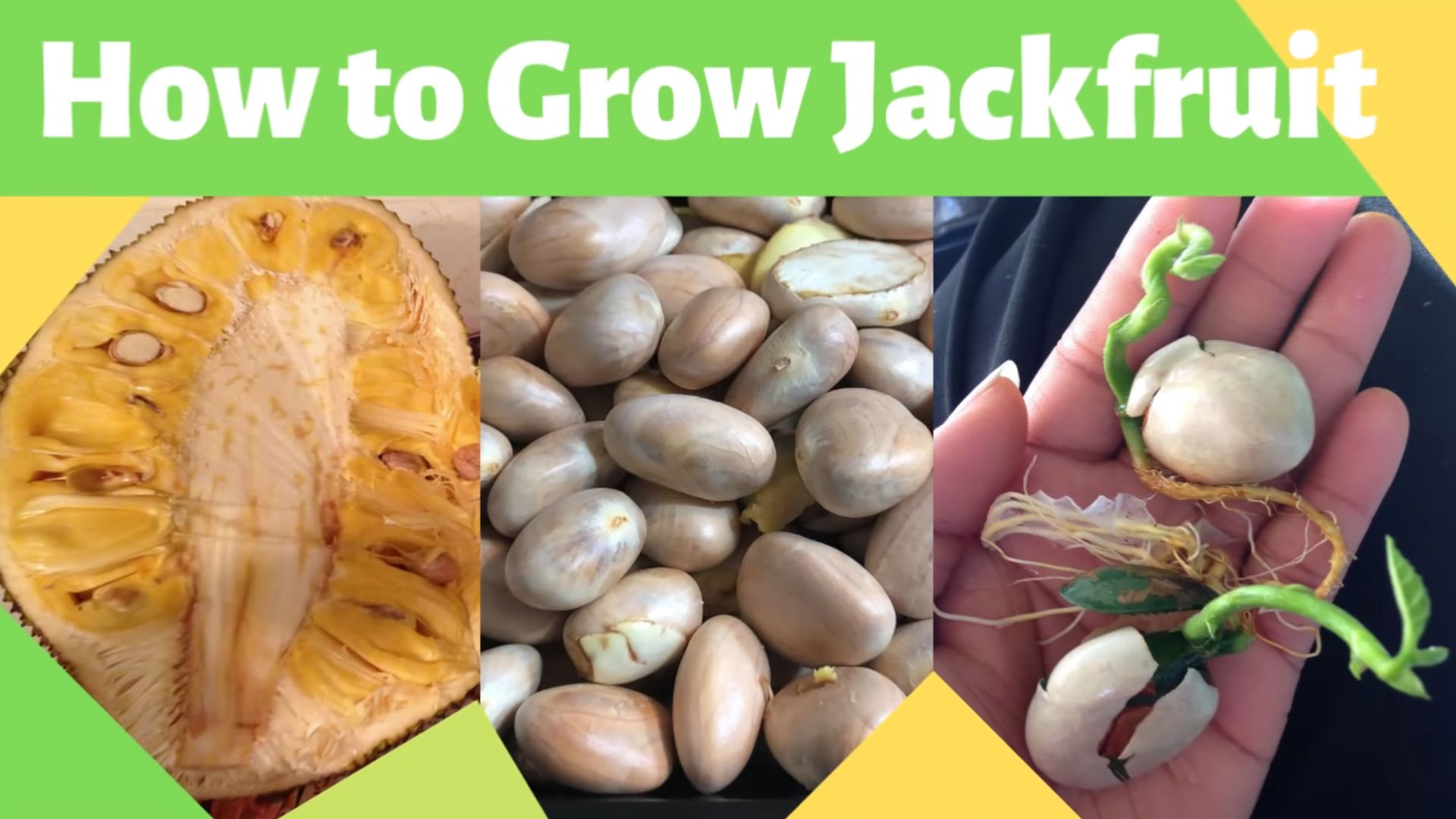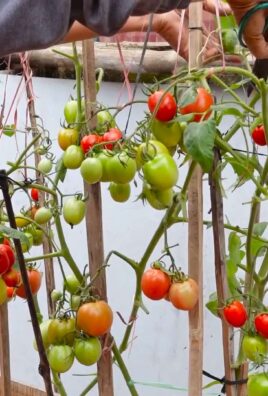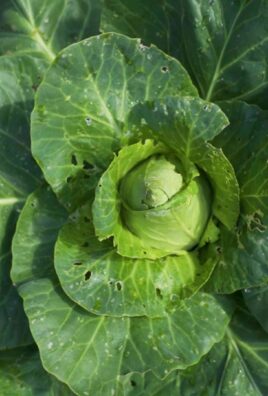Growing Jackfruit Tree at home might seem like a tropical dream, especially if you don’t live in the balmy regions where these giants thrive naturally. But what if I told you that with a few clever tricks and a little DIY spirit, you could actually cultivate your own jackfruit, even in less-than-ideal climates?
For centuries, the jackfruit has been a staple in South and Southeast Asian cuisine, revered not only for its unique flavor profile – a delightful blend of fruity sweetness – but also for its incredible versatility. From savory curries to sweet desserts, this “poor man’s food” has nourished communities and played a vital role in their culinary heritage. Imagine bringing that rich history and deliciousness right to your own backyard!
Now, you might be thinking, “Why bother? Jackfruits are huge and require specific conditions!” And you’re not entirely wrong. However, with the right DIY techniques, such as creating a microclimate, choosing dwarf varieties, and mastering container gardening, you can overcome these challenges. This article is your ultimate guide to successfully growing jackfruit tree at home. I’ll share insider tips and hacks that will empower you to nurture your own jackfruit tree, providing you with fresh, homegrown fruit and a rewarding gardening experience. Let’s get started!

Growing Your Own Jackfruit Tree: A DIY Guide
Okay, so you want to grow your own jackfruit tree? Awesome! It’s a bit of a commitment, but trust me, the reward of fresh, homegrown jackfruit is totally worth it. I’m going to walk you through everything you need to know, from choosing the right seed or seedling to nurturing your tree to maturity. Let’s get started!
Choosing Your Jackfruit Starting Point: Seed vs. Seedling
First things first, you need to decide whether you want to start from a seed or buy a seedling. Both have their pros and cons.
* Starting from Seed: This is the more economical option, and it’s super satisfying to watch your tree sprout from a tiny seed. However, it takes longer to get fruit (usually 5-7 years), and there’s no guarantee that the fruit will be exactly like the parent fruit. Jackfruit trees don’t always “come true” from seed.
* Buying a Seedling: This is the faster route to fruit (usually 3-5 years), and you’ll know exactly what kind of jackfruit you’re getting. The downside is that seedlings are more expensive. Look for grafted varieties for the best chance of getting high-quality fruit.
Finding the Right Seed or Seedling
* For Seeds: Look for seeds from a ripe, healthy jackfruit. The seeds should be plump and brown. Avoid any seeds that are shriveled or discolored. The fresher the seed, the better the germination rate.
* For Seedlings: Find a reputable nursery that specializes in tropical fruit trees. Ask about the variety of jackfruit and its characteristics (size, taste, disease resistance). Make sure the seedling looks healthy, with no signs of pests or diseases. The leaves should be vibrant green, and the stem should be sturdy.
Germinating Jackfruit Seeds (If You’re Going the Seed Route)
Okay, so you’ve decided to start from seed? Great! Here’s how to germinate them:
1. Prepare the Seeds: Gently wash the seeds to remove any pulp. You can soak them in water for 24 hours to help soften the outer shell.
2. Prepare the Planting Medium: Use a well-draining potting mix. A mixture of peat moss, perlite, and vermiculite works well.
3. Plant the Seeds: Plant the seeds about 1 inch deep in small pots or seedling trays.
4. Water and Cover: Water the soil thoroughly and cover the pots or trays with plastic wrap to create a humid environment.
5. Provide Warmth: Place the pots or trays in a warm location (around 75-85°F or 24-29°C). A heat mat can be helpful.
6. Wait and Watch: Germination usually takes 1-3 weeks. Keep the soil moist but not soggy.
7. Transplant Seedlings: Once the seedlings have a few sets of true leaves, transplant them into larger pots.
Planting Your Jackfruit Tree: Location, Location, Location!
Jackfruit trees need plenty of space and sunlight. Here’s what to consider when choosing a planting location:
* Sunlight: Jackfruit trees need at least 6-8 hours of direct sunlight per day.
* Space: These trees can get quite large (30-70 feet tall and wide), so make sure you have enough space. Consider the mature size of the tree when planting near buildings or power lines.
* Soil: Jackfruit trees prefer well-draining soil that is rich in organic matter. They can tolerate a variety of soil types, but avoid heavy clay soils that retain too much water.
* Wind Protection: Young jackfruit trees are susceptible to wind damage, so choose a location that is sheltered from strong winds.
* Climate: Jackfruit trees are tropical and subtropical plants. They thrive in warm, humid climates with temperatures between 60-95°F (15-35°C). They are sensitive to frost and can be damaged by temperatures below freezing.
Preparing the Planting Hole
1. Dig a Hole: Dig a hole that is twice as wide and as deep as the root ball of your seedling.
2. Amend the Soil: Mix the soil you removed from the hole with compost or other organic matter. This will improve drainage and provide nutrients for the tree.
3. Check Drainage: Before planting, fill the hole with water and see how quickly it drains. If the water sits for more than a few hours, you may need to improve the drainage by adding more organic matter or creating a raised planting bed.
Planting the Tree
1. Remove the Seedling: Gently remove the seedling from its pot, being careful not to damage the roots. If the roots are pot-bound (circling around the pot), gently loosen them before planting.
2. Place the Tree: Place the seedling in the center of the hole, making sure the top of the root ball is level with the surrounding soil.
3. Backfill the Hole: Backfill the hole with the amended soil, gently tamping it down as you go.
4. Water Thoroughly: Water the tree thoroughly after planting.
5. Mulch: Apply a layer of mulch around the base of the tree, keeping it a few inches away from the trunk. Mulch helps retain moisture, suppress weeds, and regulate soil temperature.
Caring for Your Jackfruit Tree: Watering, Fertilizing, and Pruning
Now that your jackfruit tree is planted, it’s time to give it the care it needs to thrive.
Watering
* Newly Planted Trees: Water newly planted trees regularly, especially during the first few months. Keep the soil moist but not soggy.
* Established Trees: Once the tree is established, water it deeply but less frequently. Allow the soil to dry out slightly between waterings.
* During Dry Periods: Water more frequently during dry periods.
* Signs of Overwatering: Yellowing leaves, root rot.
* Signs of Underwatering: Wilting leaves, dry soil.
Fertilizing
* Young Trees: Fertilize young trees every 2-3 months with a balanced fertilizer (e.g., 10-10-10).
* Mature Trees: Fertilize mature trees twice a year, once in the spring and once in the fall. Use a fertilizer that is specifically formulated for fruit trees.
* Organic Fertilizers: Compost, manure, and other organic fertilizers are also beneficial for jackfruit trees.
* Micronutrients: Jackfruit trees can sometimes suffer from micronutrient deficiencies. If you notice yellowing leaves or other signs of nutrient deficiency, consider applying a micronutrient supplement.
Pruning
* Young Trees: Prune young trees to shape them and encourage branching. Remove any dead, damaged, or crossing branches.
* Mature Trees: Prune mature trees to maintain their size and shape, improve air circulation, and remove any dead or diseased branches.
* Timing: The best time to prune jackfruit trees is after they have finished fruiting.
* Tools: Use sharp, clean pruning tools to avoid spreading diseases.
Protecting Your Jackfruit Tree: Pests and Diseases
Jackfruit trees are relatively pest and disease resistant, but they can still be affected by certain problems.
Common Pests
* Mealybugs: These small, white insects suck sap from the leaves and stems. Control them with insecticidal soap or neem oil.
* Scale: These small, armored insects also suck sap from the leaves and stems. Control them with horticultural oil or systemic insecticides.
* Fruit Flies: These pests can damage the fruit. Use fruit fly traps or netting to protect the fruit.
* Borers: These insects can tunnel into the trunk and branches. Prevent them by keeping the tree healthy and removing any damaged or diseased wood.
Common Diseases
* Root Rot: This fungal disease can occur in poorly drained soils. Prevent it by planting in well-draining soil and avoiding overwatering.
* Pink Disease: This fungal disease causes pink lesions on the branches. Prune away infected branches and apply a fungicide.
* Fruit Rot: This fungal disease can cause the fruit to rot. Prevent it by improving air circulation and applying a fungicide.
Harvesting Your Jackfruit: Patience is Key!
Harvesting jackfruit is an exciting time! Here’s what you need to know:
* Timing: Jackfruit typically takes 3-8 months to mature, depending on the variety and climate.
* Signs of Ripeness: The fruit will change color from green to yellowish-brown. The spines will become softer and more widely spaced. The fruit will emit a strong, sweet aroma. When tapped, a ripe jackfruit will sound hollow.

Conclusion
So, there you have it! Mastering the art of growing a jackfruit tree, while it may seem daunting at first, is entirely achievable with a little patience, the right knowledge, and a willingness to experiment. This DIY approach, focusing on [specific technique mentioned in the main article, e.g., seed selection and germination], offers a significant advantage over purchasing saplings, allowing you to select the strongest, most disease-resistant seeds from the most flavorful fruits. You’re essentially hand-picking the genetic potential of your future jackfruit bounty!
But why is this DIY trick a must-try? Beyond the satisfaction of nurturing a tree from its very beginning, you gain complete control over the process. You know exactly what kind of soil your tree is growing in, what nutrients it’s receiving, and how it’s being cared for. This translates to a healthier, more robust tree that’s better equipped to thrive in your specific climate and soil conditions. Plus, let’s be honest, there’s something incredibly rewarding about harvesting a giant, spiky jackfruit from a tree you personally cultivated from a tiny seed.
Consider these variations to personalize your jackfruit growing journey:
* Grafting: Once your seedling is established, explore grafting techniques to combine the hardiness of your rootstock with the superior fruit quality of a known jackfruit variety. This can significantly accelerate fruit production and ensure consistent flavor.
* Container Growing: If you live in a cooler climate, consider growing your jackfruit tree in a large container. This allows you to move it indoors during the winter months, protecting it from frost and extending its growing season. Just be sure to choose a dwarf variety that’s well-suited for container cultivation.
* Companion Planting: Research companion plants that can benefit your jackfruit tree. Certain herbs and flowers can deter pests, attract pollinators, and even improve soil health. Marigolds, basil, and sunflowers are all excellent choices.
* Soil Amendments: Tailor your soil amendments to your specific soil type. If you have heavy clay soil, incorporate plenty of organic matter, such as compost and aged manure, to improve drainage and aeration. If you have sandy soil, add peat moss or coconut coir to help retain moisture.
We wholeheartedly encourage you to embark on this exciting adventure of growing a jackfruit tree. It’s a journey filled with learning, challenges, and ultimately, the sweet reward of homegrown jackfruit. Don’t be afraid to experiment, adapt, and most importantly, have fun!
Once you’ve started your jackfruit growing journey, we’d love to hear about your experiences. Share your tips, challenges, and successes in the comments below. Let’s create a community of jackfruit enthusiasts and learn from each other! What variety did you choose? What challenges did you face? What are your best tips for success? Your insights could be invaluable to other aspiring jackfruit growers. Remember, every successful jackfruit tree starts with a single seed and a whole lot of passion. So, get planting and let the jackfruit magic begin!
Frequently Asked Questions (FAQ)
Q1: What is the best time of year to plant jackfruit seeds?
The ideal time to plant jackfruit seeds is during the late spring or early summer, after the last frost has passed. This gives the seedlings ample time to establish themselves before the onset of winter. The warm temperatures and longer days promote rapid growth and development. However, if you live in a tropical or subtropical climate with consistently warm temperatures, you can plant jackfruit seeds year-round. Just be sure to provide adequate protection from extreme heat or cold.
Q2: How long does it take for a jackfruit tree to bear fruit?
The time it takes for a jackfruit tree to bear fruit varies depending on several factors, including the variety, growing conditions, and whether the tree was grown from seed or grafted. Seed-grown jackfruit trees typically take 5 to 7 years to produce fruit, while grafted trees can start bearing fruit in as little as 3 to 4 years. Providing optimal growing conditions, such as well-drained soil, adequate sunlight, and regular fertilization, can help accelerate fruit production.
Q3: What kind of soil is best for growing jackfruit trees?
Jackfruit trees thrive in well-drained, fertile soil with a slightly acidic to neutral pH (6.0 to 7.0). The soil should be rich in organic matter and have good drainage to prevent root rot. If your soil is heavy clay, amend it with compost, aged manure, or other organic materials to improve drainage and aeration. If your soil is sandy, add peat moss or coconut coir to help retain moisture. A soil test can help you determine the pH and nutrient content of your soil and guide your amendment choices.
Q4: How much sunlight does a jackfruit tree need?
Jackfruit trees require at least 6 to 8 hours of direct sunlight per day to thrive. Choose a planting location that receives full sun throughout the day. If you live in a hot climate, providing some afternoon shade can help prevent sunburn on the leaves and fruit. Young jackfruit trees are particularly susceptible to sunburn, so it’s important to protect them during their first few years.
Q5: How often should I water my jackfruit tree?
Water your jackfruit tree regularly, especially during dry periods. Young trees need more frequent watering than established trees. Water deeply, allowing the soil to dry out slightly between waterings. Avoid overwatering, as this can lead to root rot. During the rainy season, you may not need to water your tree at all. Monitor the soil moisture and adjust your watering schedule accordingly.
Q6: What are some common pests and diseases that affect jackfruit trees?
Jackfruit trees can be susceptible to various pests and diseases, including fruit flies, mealybugs, scale insects, and root rot. Regularly inspect your tree for signs of pests or diseases and take appropriate action. Fruit flies can be controlled with traps or by bagging the fruit. Mealybugs and scale insects can be treated with insecticidal soap or horticultural oil. Root rot can be prevented by ensuring good soil drainage and avoiding overwatering.
Q7: How do I fertilize my jackfruit tree?
Fertilize your jackfruit tree regularly with a balanced fertilizer that is specifically formulated for fruit trees. Apply fertilizer in the spring and summer, following the instructions on the fertilizer label. Avoid fertilizing during the dormant season. You can also supplement with organic fertilizers, such as compost and aged manure. A soil test can help you determine the specific nutrient needs of your tree.
Q8: Can I grow a jackfruit tree in a container?
Yes, you can grow a jackfruit tree in a container, especially if you live in a cooler climate. Choose a large container with good drainage and use a well-draining potting mix. Select a dwarf variety of jackfruit that is well-suited for container cultivation. Container-grown jackfruit trees require more frequent watering and fertilization than trees grown in the ground. You will also need to protect the tree from frost during the winter months.
Q9: How do I know when a jackfruit is ripe?
A ripe jackfruit will have a strong, sweet aroma and will yield slightly to pressure. The skin will also change color from green to yellowish-brown. You can also tap the fruit; a ripe jackfruit will sound hollow. The spines on the fruit will also become softer and more pliable.
Q10: What can I do with jackfruit?
Jackfruit is a versatile fruit that can be used in a variety of dishes. Young, unripe jackfruit has a neutral flavor and a meaty texture, making it a popular substitute for meat in vegetarian and vegan dishes. Ripe jackfruit is sweet and can be eaten fresh or used in desserts, jams, and smoothies. The seeds can also be roasted and eaten as a snack.





Leave a Comment